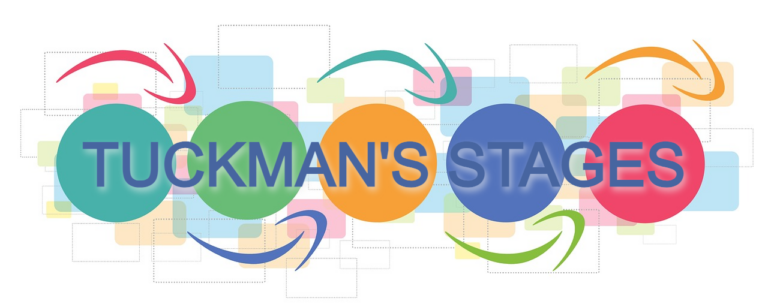Why do some teams click almost instantly while others stumble out of the gate? Or why does a group sailing smoothly along suddenly hit choppy waters? The answer lies in understanding team dynamics and effectively managing teams at each stage of their evolution.
One of the most useful and widely recognized models for team development is Bruce Tuckman’s Stages of Group Development. Since its introduction six decades ago, this framework has provided a foundational concept for business leaders, HR professionals, and managers striving to enhance team efficiency and communication.
Given how vital human interaction and collaboration have become for corporate performance, recognizing how teams evolve can mean the difference between frustration and flourishing. By acknowledging and addressing the challenges teams face at different stages of development, corporate leaders can improve team dynamics, reduce conflicts, and increase productivity.
This post explores how Tuckman’s five stages of group development apply in the workplace and what strategies can help teams thrive at each phase.
What Are Tuckman’s Stages of Group Development?
In 1965, psychologist Bruce Tuckman introduced a framework that’s become fundamental to understanding team dynamics and development. His model initially identified four stages that all teams go through—Forming, Storming, Norming, and Performing—with a fifth stage, Adjourning, added later.
Tuckman’s model is particularly valuable because it recognizes that team development isn’t always linear. Teams may progress through stages at different rates, occasionally regress when facing new challenges, or skip stages altogether depending on team composition and leadership. Understanding this fluid nature of group development is crucial for effective team management.
Let’s explore each of Tuckman’s stages of group development in detail:
1. Forming Stage
The Forming stage marks the beginning of a team’s journey. During this phase, team members are typically polite, somewhat reserved, and focused on establishing their roles within the group. There’s often a mixture of excitement and anxiety as people navigate unfamiliar territory.
In this stage, team members avoid conflict and controversy while trying to understand the team’s purpose, their responsibilities, and how they fit into the overall picture. Leaders play a critical role here by clearly defining goals, establishing basic rules, and creating an environment where team members feel comfortable introducing themselves and their capabilities.
2. Storming Stage
As its name suggests, the Storming stage can be turbulent. This is when differences in working styles, personalities, and approaches to problems begin to surface. Team members may challenge the established leadership, compete for influence, or express dissatisfaction with their roles.
Conflicts during this stage aren’t necessarily harmful—they’re a natural part of the team finding its footing. Productive conflict often leads to better solutions and stronger team bonds in the long run.
However, without proper guidance, these conflicts can derail progress and damage relationships. Leaders must facilitate open communication, mediate disputes, and help the team establish constructive ways to address disagreements. Our Conflict Resolution Training teaches proven methods for managing conflicts with respect and professionalism.
3. Norming Stage
Once a team successfully navigates the Storming stage, it enters the Norming phase, where consensus begins to form. Team members start to appreciate each other’s strengths, resolve their differences, and establish procedures for working together effectively.
The team develops a stronger sense of cohesion and commitment during this stage. Members become more comfortable providing feedback, sharing ideas, and collaborating on solutions. Trust builds as the team collectively overcomes challenges and celebrates small wins. Leaders can now step back slightly, encouraging more team autonomy while providing guidance and support as needed.
4. Performing Stage
The Performing stage represents the peak of team efficiency and effectiveness. Having established strong relationships and transparent processes, the team can focus on achieving its goals with minimal supervision.
In this stage, team members demonstrate high levels of independence, motivation, and competence. Decision-making becomes more distributed, creativity flourishes, and the team can adapt quickly to changing circumstances.
Conflicts still occur but are resolved constructively and without disrupting progress. For leaders, this is an opportunity to delegate more responsibility, focus on strategic direction, and develop team members’ capabilities.
5. Adjourning Stage
Sometimes called “Mourning,” the Adjourning stage occurs when a project concludes or the team dissolves. Team members may experience a sense of loss, especially if the team has been highly successful and cohesive.
This stage provides an opportunity for reflection, celebrating accomplishments, and consolidating lessons learned. Effective leadership during Adjourning involves acknowledging the team’s contributions, providing closure, and helping members transition to new roles or projects.
This stage is often overlooked but is crucial for organizational learning and maintaining strong, positive relationships among team members who may work together again.
Why Do the Stages of Group Development Matter to Corporate Teams?
Understanding Tuckman’s model isn’t just an academic exercise—it has profound implications for how corporate teams function and perform. When leaders recognize which stage their team is in, they can tailor their approach to address current challenges at each phase of group development and prepare for future ones.
The stages of group development are particularly relevant to modern workplace dynamics. Teamwork and communication have become increasingly complex due to remote work, cross-functional collaboration, and rapidly changing business environments. Leaders must adapt their management styles and communication strategies as teams evolve.
Mastering the stages of group development offers numerous benefits for corporate teams, including:
- Enhanced collaboration and trust among team members as they navigate challenges together.
- Reduction in destructive interpersonal conflicts that can derail projects and damage morale.
- Greater innovation and creative problem-solving as team members become comfortable sharing diverse perspectives.
- Increased productivity and ROI when teams reach and maintain the Performing stage.
- More resilient teams that can weather organizational changes and external pressures.
- Improved employee engagement and satisfaction leading to better retention of top talent.
Applying Tuckman’s Stages of Group Development in the Workplace
How do you take this model off the page and into your office? Translating theory to reality requires proactive leadership and innovative strategies. Business leaders and HR pros can use Tuckman’s stages to spot trouble early, guide teams through rough patches, and keep momentum going. Pairing this with professional team-building activities—like those from Best Corporate Events—can supercharge the process.
Here’s a simple five-step plan to manage your team through the stages:
- Set clear goals and roles upfront to kick off the Forming stage strongly.
- Encourage open dialogue to navigate the conflict-prone Storming stage without derailment.
- Track progress regularly to ensure the team builds a solid foundation during the Norming stage, maintaining alignment with goals and addressing potential issues early.
- Celebrate wins, milestones, and successes to reinforce trust and momentum through the Norming and Performing stages.
- Hold a wrap-up session during the Adjourning phase to glean lessons and insights for future projects.
For example, a program like our Competition to Collaboration® can ease Storming tensions by turning rivalry into teamwork, while a City SmartHunt® boosts the “Performing” stage by sharpening strategy, time management, and communication. Tailor these to your team’s stage, and you’ll see results.
Tips for Managing Your Team Through Group Development Stages
Leading a team through Tuckman’s stages isn’t about forcing progress but meeting them where they are. Whether you’re being directive in the Forming stage or more hands-off in Performing, adapting your style is key. (Want more on this? See our take on Leadership vs. Management.)
Here are some practical tips to keep your team on track:
- Listen actively to uncover individual and group needs.
- Shift your approach—be hands-on early, then step back as trust grows.
- Leverage team-building programs to fast-track bonding, build trust, and resolve conflicts without drama.
- Reinforce the mission to keep everyone aligned and motivated.
- Create a feedback-friendly zone where creative banter, innovative ideas, and interpersonal concerns flow freely.
These steps don’t just smooth transitions—they build a culture where teams thrive. A quick chat during Storming or a morale-boosting activity in Norming can work wonders.
Flourish throughout the Stages of Group Development with Professional Team Building Programs
Corporate team-building events can smooth transitions between stages and improve overall team dynamics. Expert-led programs like professional development workshops and team-building activities can foster smoother group development. Consider the following Best Corporate Events programs to support your team:
- Total Recall: This activity helps teams improve communication skills by setting clear role expectations and encouraging concise communication.
- Presentation Skills Training: Empower team members to present their ideas clearly and confidently, improving communication effectiveness.
- Myers-Briggs Type Indicator (MBTI) Training: Help team members understand each other’s personality preferences and work styles, fostering better collaboration and reducing conflict.
- Manager’s Guide to Business Coaching: Teach team leaders proven techniques and best practices for absorbing feedback, building trust, and helping employees reach higher performance levels.
- Emotional Intelligence Training: Participants learn how to manage their emotions more effectively and relate empathetically to others.
By working with Best Corporate Events, you can create tailored team-building solutions based on your team’s unique needs and accelerate their journey through Tuckman’s Stages of Group Development. Contact us today for an assessment of your needs and a consultation on customized leadership and team-building activities.






